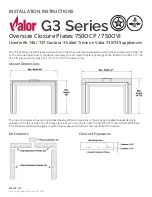
107
GB
Ionisation current control
When calibration has been performed and after having carried out the combustion tests, it is good practice to check
the control electrode is correctly positioned: this is carried out by measuring the ionisation current.
Use a micro ammeter, to be inserted into the electrode seat. The minimum value of the current must be such as those
reported in the table and be quite stable.
Normally the flame surveillance circuit is insensitive to the negative effect of the ignition spark on the ionisation
current. If the disturbing effects of the ignition spark on the ionising current are excessive, the polarity of the electric
connections of the ignition transformer primary must be inverted and/or check the location of the ignition electrode
in relation to the ionisation electrode.
Flame control takes place via the detection electrode, making use of the ionisation phenomenon.
c) Carry out a functioning cycle and, when burner ignition has been checked, close the gas supply in order to
obtain flame switch-off:check the repetition of a cycle and consequent block shutdown caused by no ignition at
the end of the safety time!
d) Carry out a functioning cycle and, when burner ignition has been verified, open the contact relative to the air
pressure switch:verify the immediate switch off of the solenoid valve and consequent block shutdown caused by
air pressure switch anomaly after 10s!
e) Close the air pressure switch contact and then make a functioning request:verify the non-activation of the motor
and consequent block shutdown caused by air pressure switch anomaly after 10s!
Prolonged switch-off
If the burner must remain inactive for a long period, close the gas cock and remove the current to the appliance.
PARAsIte flAMe
flAMe PReseNCe
flAMe swItCH-Off
IONISATION CURRENT
(uA DC)
> 0.8 +/- 15%
> 1.5 +/- 15%
< 1.2 +/- 15%
FLAME RESISTANCE
(MOhm)
< 95 +/- 15%
< 50 +/- 15%
> 70 +/- 15%
Flame signal detection threshold:










































